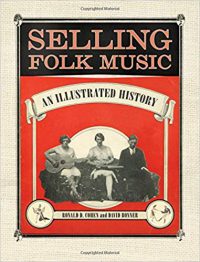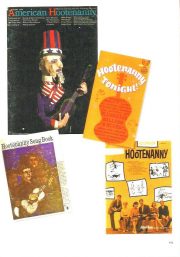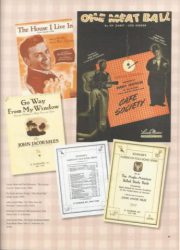This title was designed to portray the various setups, styles, collages, and the cover art of both scores, books, festival ads, piano rolls, and vinyl that was marketed and sold in packages that related to the musical content of “folk music” in the United States at a certain period. So there is not too much text presented in the volume, but instead it offers tons of great pictures.
 On just five pages the authors give a concise and excellent introduction to the different decades and their artists, the strategies of the publishing houses and record companies from the early 1900s to the 1970s, where the overview ends. However, several other academic titles on folk music are pointed out in detail; it is to those that Selling Folk Music serves as a visual companion.
On just five pages the authors give a concise and excellent introduction to the different decades and their artists, the strategies of the publishing houses and record companies from the early 1900s to the 1970s, where the overview ends. However, several other academic titles on folk music are pointed out in detail; it is to those that Selling Folk Music serves as a visual companion.
“Folk music in the United States – mostly based on Anglo-Saxon and African roots, but also including numerous ethnic styles and sources from throughout the world – has had a varied and complex scope and lineage, including the blues, minstrel tunes, Victorian parlor songs, spirituals and gospel tunes, hillbilly/country/cowboy/western songs, calypsos, pop folk, folk-rock, ethnic, bluegrass, and a range of so much more.”
 Already in the late 1950s folk music turned out to be a successful product for the record companies, bands like the Kingston Trio and the Weavers sold thousands of copies; several new labels were founded and specialized in that genre. Simultaneously, so-called “authenticity” – as the songs were often introduced to have originated in a rural/working class environment – was desperately tried to recreate on the packaging of the folk music products. “The hootenanny craze of 1964, for example, spawned such items as a candy bar, pinball machine, bath powder, paper dolls, Halloween costumes, and beach towels. Such a wide range of images will give a broad and complex picture of the impact that folk music and folk musicians had in transforming public styles and scope into the 1970s.”
Already in the late 1950s folk music turned out to be a successful product for the record companies, bands like the Kingston Trio and the Weavers sold thousands of copies; several new labels were founded and specialized in that genre. Simultaneously, so-called “authenticity” – as the songs were often introduced to have originated in a rural/working class environment – was desperately tried to recreate on the packaging of the folk music products. “The hootenanny craze of 1964, for example, spawned such items as a candy bar, pinball machine, bath powder, paper dolls, Halloween costumes, and beach towels. Such a wide range of images will give a broad and complex picture of the impact that folk music and folk musicians had in transforming public styles and scope into the 1970s.”
The emphasis of this large-scale book is clearly on the visual aspects of the topic. Particular attention is given to the 1960s, when the folk revival picked up speed and seemingly anywhere in the US, from New York City to San Francisco people met to sing and celebrate folk songs and country songs, perform ballads of cotton pickers, miners, laborers and railway men. At least, this impression is transported in the many different designs where cowboys, miners, lumberjacks, barn dancers, fiddlers, and banjo pickers have a special place on the covers of the many promotional products.
 Almost 500 beautiful reproductions in their original colors are compiled here and give a vivid impression of roughly seventy years of folk music representations and commercial means of exploitation.
Almost 500 beautiful reproductions in their original colors are compiled here and give a vivid impression of roughly seventy years of folk music representations and commercial means of exploitation.
Highly informative reading and a feast for folklorists and product designers alike.
Author David Bonner is a copywriter, Ronald D. Cohen is professor emeritus of history at Indiana University Northwest. He has published on folk music, folklore collectors and music in American society.
Review by Dr. A. Ebert © 2018
Ronald D. Cohen and David Bonner. Selling Folk Music: An Illustrated History (American Made Music Series). University Press of Mississippi, 2018, 176 p.
